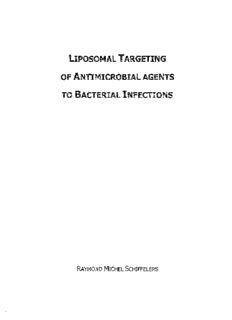
lIPOSOMAl TARGETING OF ANTIMICROBIAL AGENTS TO BACTERIAL INFECTIONS PDF
Preview lIPOSOMAl TARGETING OF ANTIMICROBIAL AGENTS TO BACTERIAL INFECTIONS
lIPOSOMAl TARGETING OF ANTIMICROBIAL AGENTS TO BACTERIAL INFECTIONS RAYMOND MICHEL SCHIFFELERS Liposomal targeting of antimicrobial agents to bacterial infections by Raymond Michel Schiffelers. Thesis Erasmus universllyMedical Center Rotterdam - With bibliography - With references - With summary in Dutch Ms. C.M. Luteijn is thanked for the technical realization of my cover design ISBN 90-9014452-8 Subject headings: drug targeting! Iiposomes ! bacterial infections © 2000 R.M. Schiffelers. No part of this publication may be reproduced, by any means, without prior permission. lIPOSOMAl TARGETING OF ANTIMICROBIAL AGENTS TO BACTERIAL INFECTIONS HET DOELGERICHT AFLEVEREN VAN ANTI-MICROBIELE MIDDELEN AAN BACTERIELE INFECTIES MIDDELS LIPOSOMEN PROEFSCHRIFT TER VERKRDGING VAN DE GRAAD VAN DOCTOR AAN DE ERASMUS UNIVERSITEIT ROTTERDAM OP GEZAG VAN DE RECTOR MAGNIFICUS PROF. DR. IR. J.H. VAN SEMMEL EN VOLGENS BESLUIT VAN HET COLLEGE VOOR PROMOl1ES DE OPENBARE VERDEDIGING ZAL PLAATSVINDEN OP WOENSDAG 7 FEBRUARI 2001 OM 15.45 UUR DOOR RAYMOND MICHEL SCHIFFELERS GEBOREN TE 'S-GRAVENHAGE PROMOTIECOMMISSIE Promotoren: Prof. dr. H.A. Verbrugh Prof. dr. G. Storm Overige leden: Prof. dr. A.M.M. Eggermont Prof. dr. R. de Groot Prof. dr. J.W.M. van der Meer Copromotor: Dr. LAJ.M. Bakker-Woudenberg The studies presented in this thesis were performed at the Department of Medical Microbiology & Infectious Diseases, Erasmus university Medical Center Rotterdam, Rotterdam, The Netherlands, and the Department of Pharmaceutics, Utrecht Institute for Pharmaceutical Sciences, Utrecht University, Utrecht, The Netherlands. The research was supported by grant 902-21-161 from the Dutch Organization for Scientific Research (N.W.O.). The publication of this thesis was financially supported by: Dr. Ir. Van de Laar Stichting, Heerlen; Dr. Saal van Zwanenbergstichting, Oss; Nederlandse Organisatie voor Wetenschappelijk Onderzoek (N.w.O.), Den Haag Ter herinnering aan mijn moeder CONTENTS 1. General Introduction 9 2. Localization of sterically stabilized liposomes in Klebsiella pneumoniae-infected rat lung tissue: influence of liposome characteristics 31 3. Host factors influencing the preferential localization of sterically stabilized liposomes in Klebsiella pneumoniae infected rat lung tissue 47 4. Localization of sterically stabilized liposomes in experimental rat Klebsiella pneumoniae pneumonia: dependence on circulation kinetics and presence of poly(ethylene) glycol-coating 67 5. Liposome-encapsulated aminoglycosides in preclinical and clinical studies 81 6. Therapeutic efficacy of liposome-encapsulated gentamicin in rat Klebsiella pneumoniae pneumonia in relation to impaired host defense and low bacterial gentamicin-susceptibility 105 7. In vivo synergistc interaction of liposome-co-encapsulated gentamicin and ceftazidime 125 8. Summary 143 9. Samenvatting voor niet-ingewijden 153 List of Publications 161 Curriculum vitae 165 Nawoord 167 Abbreviations 171 8 1. General Introduction Summary Failure of antimicrobial treatment is observed frequently in hospitalized patients resulting in morbidity and mortality, A possible way to improve antimicrobial treatment is the targeted delivery of antimicrobial agents, This thesis describes a study on tihe use of long-Circulating liposomes for the targeted delivery of antimicrobial agents to sites of bacterial infections, In this chapter an introduction is given on the use of targeted drug delivery in infectious diseases, which is followed by the aims and outline of this thesis, 9 Chapter 1 1. Infectious diseases Infectious diseases remain an important cause of morbidity and mortality in the Western world, especially in hospitalized patients. The long, invasive, and intensive hospital treatments lower the barriers to microbial invasion of host tissues and compromise the development of an adequate inflammatory/immune response. In addition, the host response may be weakened by administration of immunosuppressants or cytotoxic drugs or as a result of a pathology that affects the host defense. Under these circumstances antimicrobial treatment frequently fails. This thesis focuses on ways to increase the efficacy of antimicrobial treatment against bacterial infections. Bacteria are unicellular prokaryotic organisms with a circular double-stranded deoxyribonucleic acid (DNA) molecule that bears the genetic information (Salyers, 1994). Additional genetic information may be present in the form of plasmids, small extrachromosomal, self-replicating, and transferable DNA molecules (Actis, 1999; Davison, 1999). Some components of the bacterial cell wall, like peptidoglycan, (Iipo)teichoic acid and lipopolysaccharide (LPS), are toxic molecules known as endotoxins (Seydel, 2000; Wiese, 1999; Sriskandan, 1999). In addition, bacteria may also secrete soluble toxic proteins, known as exotoxins (Guerrant, 1999; Middlebrook, 1984, Lesieurs, 1997). These toxins have detrimental effects on the infected host, as they may destruct host cells or structures and may affect host homeostasis. The effects of toxins on host cytokine profiles may lead to disseminated intravascular coagulation, severe inflammatory response syndrome and ultimately septic shock and multiple organ failure by distorting the balance between pro inflammatory and anti-inflammatory stimuli (Bone, 1997; Deitch, 1999; van der Meer, 1999). 2. Antimicrobial treatment Impediment of bacterial contamination and colonization, for example by sterilization, disinfection, or isolation is a way to prevent the development of infectious diseases. Once the bacteria have invaded the host, the aspecific and speCific host defense become activated to control the infection. For prevention or treatment of bacterial infections antimicrobial 10
Description: